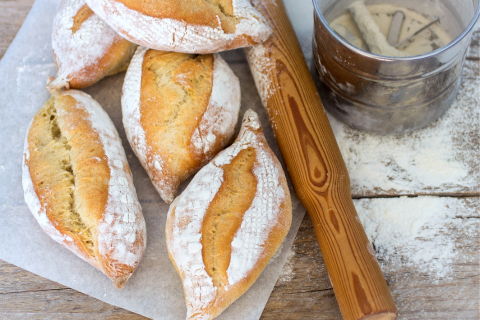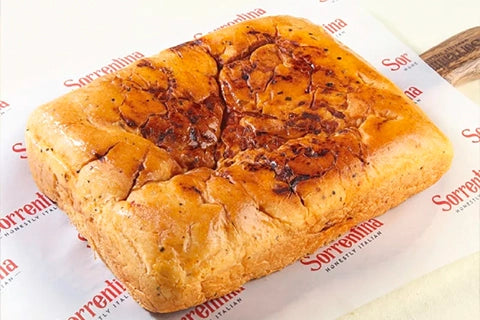Italian Breads: A Centuries Old Love (Loaf) Story
When you walk into an Italian kitchen, bread is never JUST bread. Italians don’t just love bread, the success of their meals thrives on it and they believe that each cherished loaf has a specific role to play when it’s time to eat. The Italian baker from Puglia, Antonio Cera, is the founder of Italy’s most ancient bread-making techniques.
Italian bread is not just limited to basic garlic bread, it goes way beyond. Whether used to mop up sauce or as an appetiser with meats and cheeses, bread is a crucial part of the Italian food platter.
You will rarely come across an Italian meal that does not include Italian bread. Italy has an incredible variety of breads, with various regional variations of flatbread, sourdough, and the traditional loaf. If you get a chance to try each and every one of these - you’re sure to find a new favourite!
Italians and their love for their bread will range throughout the different regions of the country. Are you ready to explore the variety they have to offer?
P.S. - Try not to get hungry in the process.
1. Ciabatta
Ciabatta is an Italian bread that is known for its distinctive shape and texture. It is a relatively new bread, created in the 1980s by Arnaldo Cavallari, a baker from Verona, Italy. The bread was inspired by French baguettes but with a more rustic, chewy texture and a thicker crust.
This bread is made with a high-hydration dough that is fermented for a long time, which gives it a unique texture and flavour. The dough is typically made with flour, water, salt, and a natural sourdough starter, which is at times yeast. The dough is mixed together and then allowed to rise for several hours before being shaped into a distinctive flat, elongated shape.
This versatile Italian bread can be used in making sandwiches, toasted and served with butter, olive oil, or cheese, used as a dipping bread for pastas, soups, or stews, and paired along with Italian cured meats, cheeses, and antipasti.
Our Whole Wheat Ciabatta Bread can be opted for when you want to order fresh breads online. Made using our own sourdough culture, our Ciabatta Bread dough is kept to rest overnight and freshly baked every morning after thus giving it a crusty, yeast-free exterior, and an airy yet chewy interior.
2. Focaccia
Focaccia is a traditional type of Italian bread that is known for its fluffy and chewy texture and delicious flavour. Its origins date back to ancient Rome when it was known as "panis focacius".
The word "focaccia" comes from the Latin "focus," meaning "hearth" or "fireplace," which is where the bread was traditionally baked. Focaccia is now associated with the Liguria region of Italy, where it is often eaten as a snack or appetiser.
Made using all-purpose flour, salt, dry yeast, and olive oil, Focaccia bread often has optional toppings of rosemary, sliced tomatoes, olives, garlic, or grated cheese. This Italian bread is typically served as an appetiser or snack, or either used as a base for pizzas, sandwiches or panini. Focaccia pairs well with a variety of foods, including cheese, cured meats, and roasted vegetables. It is often also served alongside a glass of wine, such as a Chianti or Pinot Noir.
If you’re looking to order breads online, our Pomodoro Focaccia Bread should be your pick as it champions the flavours of Italy and is baked fresh every morning with sun-dried tomatoes, and a bold in-house spice mix. The result is a yellow-red hued finish with a crusty top and bottom along with a spongy interior owing to our natural resting process.
3. Panettone

Panettone is a sweet Italian bread that is a traditional Christmas dessert in Italy. Its origins can be traced back to Milan in the 15th century, where it was originally made for the aristocracy. The name "panettone" comes from the Italian words "pane" (bread) and "ettone" (big).
Legend has it that a young baker named Toni created the first panettone by accident when he added extra butter and dried fruit to his dough. His creation was so well-received that it became a popular holiday treat throughout Italy.
This Italian bread is made using flour, yeast, sugar, butter, eggs, milk, and dried fruit. The dough is mixed and then allowed to rise for several hours. It is then shaped into a tall, cylindrical shape and baked. The baking process can take several hours, but the result is a fluffy, airy bread with a sweet, rich flavour.
Panettone is typically served with coffee or hot chocolate, and it is often toasted and spread with butter or jam, served with sweet wine or champagne, which helps to balance out the rich sweetness of the bread, or enjoyed as a dessert, breakfast pastry, or a snack. Some people even use it as a base for ice cream sundaes or trifle desserts. Overall, panettone is a versatile and delicious treat that is beloved by many Italians and non-Italians alike.
While these breads are immensely popular and have their own fanclubs, there are a few other kinds of lesser known Italian breads. Let us further explore the hidden gems of Italy -
4. Grissini

Grissini, also known as breadsticks, are thin, crispy sticks of bread that are often served as a snack or appetiser. They are typically made with a simple dough of flour, water, yeast, and salt, and can be flavoured with herbs, cheese, or other ingredients.
5. Ciriola

Hailing from the region of Lazio, Ciriola is a traditional Roman bread that captures the essence of Italy's capital. This small, round loaf boasts a crispy crust and a soft, chewy interior, making it perfect for panini sandwiches or served as a rustic accompaniment to meals. Its unique texture and slight tanginess stem from being made with a combination of wheat and sourdough flours.
6. Pagnotta

Originating in central and southern Italy, Pagnotta is a large, rustic loaf that epitomises the simplicity and authenticity of traditional Italian bread. This round or oval-shaped bread features a thick crust and a moist, porous crumb, achieved through a slow fermentation process. The dough is often made with durum wheat flour, which imparts a nutty and hearty flavour.
7. Filone

Moving to the northern regions of Italy, we encounter Filone—a traditional Italian bread that personifies simplicity and tradition. Hailing from areas like Piedmont and Lombardy, Filone is a long, oval-shaped loaf with a golden-brown crust and a tender crumb. The dough is typically made using a combination of wheat flour, water, yeast and a touch of olive oil, allowing the natural flavours to shine.
8. Pane Toscano

Pane Toscano is a traditional Tuscan bread that is known for its dense, chewy texture and slightly sour flavour. It is often used for soups and stews, as it can absorb liquid without becoming mushy.
9. Pizza Bianca

Pizza Bianca is a type of bread that is similar to focaccia, but is typically thinner and crispier. It is topped with olive oil, salt, and sometimes rosemary, and is often served as a snack or appetiser in Italy.
In the vast expanse of Italian bread culture, these Italian breads stand as unsung heroes, each representing a region's distinct traditions and diverse flavours. As we explore the lesser-known Italian breads, we discover a culinary tapestry woven with care, passion and the indelible spirit of Italy. If you are also looking forward to exploring these authentic, Nonna-approved, Italian breads, then you can buy bread online via our website.
Our breads are freshly baked on the same day and home delivered to you when you buy bread online through us. Order in and stock up your kitchen with Italian breads for a whole and hearty meal. You can also hit ‘follow’ on our Instagram page @sorrentina_honestlyitalian to explore more honestly Italian ways of life!



